Cultural Tourism
GWANGYANG
Cultural Tourism
Local Produce
Jakseol Tea (Wild First Flush Green Tea)
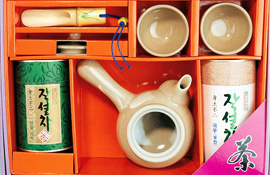
Outstanding young buds are collected in Simsan Valley of Baegunsan Mountain before April 20th, known as Goku (one of the 24 subdivisions of the season). Processed by a traditional method, it is considered the highest quality green tea with exceptional scent and taste. Boasting a long history, the tea is known for containing a rich array of nutrients including vitamin C, minerals, tannins, and fluorine. It is effective for clearing the mind and body, restoring vigor, treating constipation, treating hangovers, and enriching skin. It also has diuretic effects that help release bodily waste, prevent adult diseases, and fights against cancer.
Chestnuts
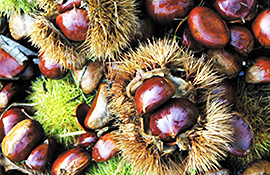
Gwangyang was the first place in Korea to build a chestnut production complex. Baegunsan Mountain, the home of chestnuts produced in Gwangyang, boasts abundant sunlight and rich soil, which provide an ideal environment to grow outstanding chestnuts. A typical chestnut weights 20 to 25g, but a Gwangyang chestnut weights over 30g. Their sweet and savory taste makes Gwangyang chestnuts extremely popular in Korea.
Maesil (Plums)
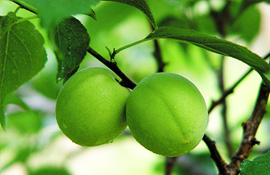
On the outskirts of Baegunsan Mountain and surrounded by the Seomjingang River, Gwangyang is the home of the Gwangyang Maehwa Festival. The city is also known for producing high quality plums. Abundant sunlight and balmy climate reduced the number of cold days during the blooming period of plums. A large plum complex, the largest such complex in Korea, produces over 30% of the plums produced in Korea. It was scientifically proven that abundant sunlight, rich soil, and pristine water help Gwangyang plums contain over 11 nutrients including calcium and citric acids, benefiting those consuming them.
Dried Persimmon
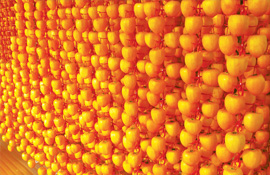
Milsi persimmons, grown on Baegunsan Mountain, are dried under clean water and sunlight of the Eochi Valley. Dried persimmons here are known for having an elegant color, sweetness, and soft texture. Quality of dried persimmons varies depending on varieties of persimmons. In general, round types (Dungsi Persimmon, Susi Persimmon, and Wolhasi Persimmon) and elongated types (Gojongsi Persimmon and Danseongsi Persimmon) are known for having high quality. Especially, Milsi persimmons have the reputation of exceptional quality.
Gorosoe Water

Gorosoe Water, Mysterious Water Given by Deities Gorosoe water is extracted from painted maples. Gorosoe (painted maple) is designated as the city tree. Painted maples grow naturally in valleys of Baegunsan Mountain. Gorosoe water is produced the most under negative 3 to 4 degrees Celsius at night and 10 to 15 degrees in the afternoon (with the temperature change between night and day over 15 degrees). The water is known for containing a rich amount of minerals such as sucrose, sodium, magnesium, calcium, and iron as well as vitamin B1, B2 and C.
Gorosoe Fermented Bean Paste and Soy Sauce

Developed to promote people’s health, Gorosoe fermented bean paste and soy sauce are based on Gorosoe water, locally grown beans, and natural salt. Then, following the traditional method, it is fermented in a pot for two years or more. Combining natural ion water with traditional food, Gorosoe fermented bean paste and soy sauce completed the certification of ingredients for export by the Korea Food Research Institute as well as clinical trials by Gwangyang Health Sciences University. It is chosen as an outstanding food brand with quality certification by the Governor of Jeollanam-do. Gorosoe soy sauce can be used for making soups, seasoned wild greens, and seaweed soup for pregnant women; Gorosoe fermented bean paste can be served for stews, soups, and condiments for roasted meat.
Jangdo
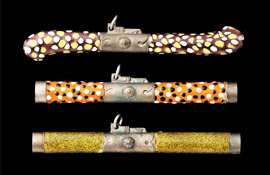
Jangdo, also known as Eunjangdo (silver-decorated knife), has been mainly carried by classical scholars and women since the Goryeo Period. Gwangyang Jangdo was known as one of the highest quality knives; even King Sejong the Great carried one. Special processing and hardening on the edge of the knife heightens its practical use. Knife, sheath, edge of knife, and decorations lead to balanced beauty. Overall, Gwangyang Jangdo boasts durability as well as high art quality.
Gungsi
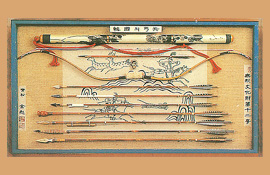
Materials used for Gwangyang Gungsi (traditional arrows) include green bamboo, pheasant feather, and arrow nocks made of peach trees. Gungsi involves the meticulous process involving more than 120 handmade steps. Currently, Master Kim Gi (Intangible Cultural Property No. 12) is inheriting the heritage of Gungsi. Recently, similar but inexpensive crafts were also produced. Master Kim Gi is also an outstanding archer. He tests his crafts by shooting them to ensure that they offer high elasticity and target-hit rate.
Gwangyang Jukpil (Bamboo Pen)
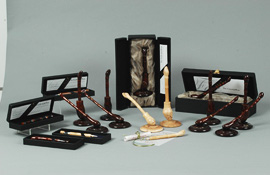
This bamboo pen relies on traditional crafting using the natural beauty of bamboo, loess, ramie fabric, nacre, gold, and lacquer. Its entire production process is handmade, from collection of bamboo to decoration. This high quality craft boasts traditional elegance, modern sophistication, and practicality, conveying unique art quality to those who use it.